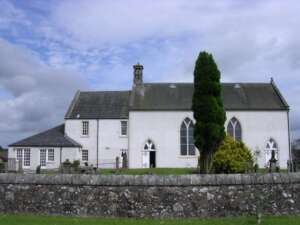
Fossoway Parish Church (KY13 0UY) can be found in the Crook of Devon which lies approximately 6 miles from Kinross on the A977 signposted at junction 6 on the M90.
Fossoway St Serf’s and Devonside Church is a church that lies at the heart of our community and that also strives to have a heart for the community. With Christ at the centre of all we do, we seek to be a place where people of all ages may find themselves at home, and may learn and grow in Christ.
The church building and entrances are fully accessible for people of all abilities.
The church is equipped with projector, microphones, speakers and hearing loop system.
All are welcome, you don’t have to be a member.
The Elizabeth Wilkie Hall is also equipped with a projector and surround sound which makes it ideal for film nights, presentations with AV, meetings and private functions.
History of Fossoway Church
The present Fossoway St Serf’s and Devonside church building was built in 1729, remodelled in 1806 and extended in 2000 when the Elizabeth Wilkie church hall was added. During the construction of the hall a time capsule was placed in the foundations containing the story of the life of the church in the 20th century.
The Church building is ‘C’ listed and the churchyard contains one of the few ‘Hearse Houses’ still left in Scotland.
In 1963 the Church of Scotland (St Serf’s Church) and the Free Church (Devonside Church) were united to form the present church. Later, in 1980, Fossoway church was linked with Cleish Parish Church.
There has been Christian teaching in this area since the time of St Serf and the earliest mention of a place of worship in the parish is in 1462. The parish of Fossoway includes the settlements of Crook of Devon, Drum, Carnbo, Rumbling Bridge, Powmill and the accompanying rural areas,
An Excerpt from the 1861 Parochial Directory for Fife and Kinross
PARISH OF FOSSOWAY AND TULLIBOLE.
THIS PARISH, of which the chief portion is in Perthshire, lies to the west of Kinross-shire. It is bounded on the north by the parish of Dunning, on the east by Orwell and Kinross, on the south by Cleish, Dunfermline, Torryburn, and Saline, and on the west and north-west by Clackmannanshire and Muckhart. It is about eleven miles long, by ten at its greatest breadth; but its form is very irregular, and its total superficial area is not reckoned at above 50 square miles.
The united Parish consists of three districts in Perthshire belonging to Fossoway, which were to a great extent separated from one another, until consolidated by the insertion of Tullibole, belonging to Kinross-shire, amongst them.
The northern parts of Fossoway, and the part of Tullibole which connects them, constituting the entire northern section of the united parish, are a continued congeries of hills running up to the centre of the Ochil range, some of their summits rising to from 600 to 1100 feet above the level of the sea. Some of the hills are covered with moss or heath, but most are green to the summit, and afford good pasture for sheep and black cattle.
The central and southern sections, consisting of the main body of Tullibole and the southern part of Fossoway, though considerably elevated above sea-level, are arable over most of their area, with an improvable soil of gravel, clay, till, and loam. Tullibole, though appearing between the Cleish Hills and the Ochils to be a level country, is yet the highest ground in the plain which stretches between Kinross and Stirling, and sends off its brooks in the opposite directions of east and west. Owing to the attraction of the hills on either side, it has many cloudy and rainy days, and later seasons than the adjacent districts.
The Devon, though winding through the Perthshire section of the Parish for a number of miles, only touches the County at the Crook-of-Devon; and the two Queichs and the Gairneys, which drain the Parish on the north and east, have been shortly noticed in the introduction to the County. The principal minerals are- coal, limestone, sandstone, and ironstone, none of which, however, are wrought in the Kinross section of the Parish.
The Parish is traversed by the road from Kinross to Stirling, and by other turn-pike and statue-labour roads ; and the Devon Valley Railway, now in course of formation, runs through the centre of the Parish, from east to west.
Fossoway and Tullibole were united into one parish about the year 1614; but for a long time afterwards both Churches were used – the minister officiating two Sabbaths in Fossoway and one in Tullibole; but in 1729 a new Church was built for the united Parish, since which period there has been only one Parish Church. There are also a Free Church at Fossoway, and a Chapel of Ease at Blairingone in Perthshire. The Parish School is a little to the east of the village of Crook-of-Devon, in addition to which there are a Free Church School at Fossoway, and a Subscription School at Carnbo.